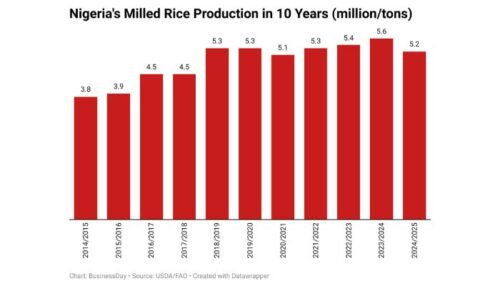High Costs Force Farmers to Reduce Cultivation
Rice production in Nigeria has reached its lowest level in four years. Rising input costs have forced many farmers to reduce the size of their farmland.
A recent report from the United States Department of Agriculture (USDA) shows that rice production declined by 7% in the 2024/2025 season. Output fell to 5.23 million metric tons (MT) from 5.61 million MT in the previous season. Some estimates suggest an even sharper decline of 15% to 23%.
The USDA data also indicate that this is Nigeria’s lowest rice output since 2020. That year, the COVID-19 pandemic disrupted farming activities nationwide.
Farmers Struggle with Rising Prices and Market Challenges
Many farmers say the soaring cost of inputs has reduced their profits. Insecurity, climate change, and the influx of cheaper imported rice have worsened the situation.
“The prices of inputs have increased four to five times already, and they are still rising,” said Muhammed Augie, former chairman of the Rice Farmers Association in Kebbi State.
He explained that many farmers have switched to lower-cost crops. Those still growing rice have significantly reduced their cultivation areas.
Ahmed Idris, a rice farmer in Jigawa, shared a similar experience. He previously farmed five hectares but has now cut it down to two hectares.
“The amount I used to spend on five hectares two years ago is now only enough for two,” he said. He added that government subsidies for rice farmers were much higher before the Anchor Borrowers Programme was suspended.
The Suspension of the Anchor Borrowers Programme
The federal government suspended the Anchor Borrowers Programme last year. This initiative was designed to boost rice production but was halted due to fraud allegations and widespread loan defaults.
Under former President Muhammadu Buhari, Nigeria launched a “rice revolution.” While data is limited, the Food and Agriculture Organization (FAO) estimates that paddy rice production rose from six million metric tons in 2015 to 8.9 million metric tons in 2023.
During this period, the number of rice mills also increased. The Rice Processors Association of Nigeria (RIPAN) reported that mills grew from just 10 in 2015 to over 100 by 2023.
Despite this growth, Nigeria’s rice yields remain lower than those of many African nations. The country’s average rice yield per hectare increased from 1.9 metric tons to 2.47 metric tons. However, this is still below Ethiopia’s 3.4, South Africa’s 2.9, and Kenya’s 4.2 metric tons per hectare.
Rice Millers Struggle with Supply Shortages and Rising Costs
Millers are also feeling the impact of reduced production. Paddy rice prices have surged by 100%, now costing between N70,000 and N80,000 per 80kg bag.
RIPAN reports that Nigeria needs 11 million metric tons of paddy rice to meet domestic demand. However, current production stands at only 4.6 million metric tons.
Although Nigeria’s rice milling industry has a processing capacity of 7.5 million metric tons, many mills are underutilized. The Rice Millers Association of Nigeria (RIMAN) noted that rising production costs have forced many millers to shut down.
“A large number of millers have closed due to high costs,” said Peter Dama, National Chairman of RIMAN.
He explained that electricity prices have tripled. The cost of raw materials has also surged, along with transportation expenses.
“How can we compete under these conditions, especially with high borrowing costs?” he asked. He also noted that imported rice is flooding the market, making competition even tougher.
Government Interventions Face Foreign Exchange Challenges
To support struggling millers, President Bola Tinubu granted import-duty waivers for rice paddy importers. However, foreign exchange volatility has made it difficult for processors to import rice at competitive prices.
Many stakeholders believe that without additional government support, Nigeria’s rice industry will continue to face serious challenges.




